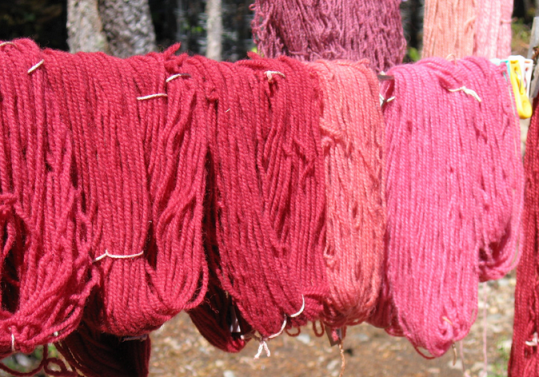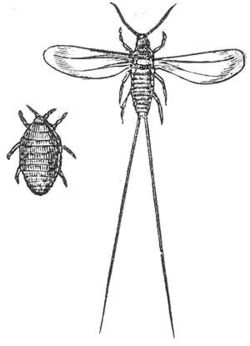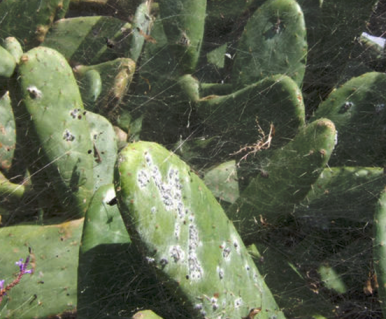In the series of useless facts and trivia, here’s the story of food additive E120, also known as carmine or crimson.
 It’s in your food, lipstick, sweets, meat, clothes, drinks and make up. Chances are, you’ll find it in anything reddish that is not naturally red (forget ketchup – I checked.). And you could say it’s totally organic, if not in line with Buddhist, Muslim or vegan principles.
It’s in your food, lipstick, sweets, meat, clothes, drinks and make up. Chances are, you’ll find it in anything reddish that is not naturally red (forget ketchup – I checked.). And you could say it’s totally organic, if not in line with Buddhist, Muslim or vegan principles.
So sit near the fire, children, and let me tell you the story of spies, bugs, state secrets, indians, daring travel and cacti in the new world.
 Cochineal is a tiny little flea, that lives on certain cacti in South America. They don’t look like much, and are in fact not red at all, except on the inside… there, a deep crimson hue. The Aztec and Maya indians had used them for dying fabrics for centuries. Europeans, always after the riches of others got whiff of it, and the royal red colour was highly priced.
Cochineal is a tiny little flea, that lives on certain cacti in South America. They don’t look like much, and are in fact not red at all, except on the inside… there, a deep crimson hue. The Aztec and Maya indians had used them for dying fabrics for centuries. Europeans, always after the riches of others got whiff of it, and the royal red colour was highly priced.
Red, black and white are the three colours found in every single culture, at any point through human existence. Chalk, iron oxide and ash. Add sienna, and you have the traditional palette of Australian aborigines. Never mind the enormous symbolic values of red (hate, love, death, birth, fire, royalty, blood etc ), the problem was not to dye something red, the problem was to make it fix, to ‘set’ in the fabric. Not going to get into details of dyers in the olden times having pots in the street for passerbys to peein, as it is a fixative, or the alum mordants. Boring. No action.
The conquistadors had it almost all to themselves, in the new world. Gold, silver and red. They weren’t going to tell anyone, and it it was an enormous business, exporting tons of dried insects to Europe. Painters, followers of fashion, cosmetics, fabric dyeing. The spanish had monopoly on red. Fixable, deep red. Big business.
Cochineal means grana fina, and indicated that it was a seed that produced the royal colour. This misunderstanding kept the other europeans in the dark for a long time- they sneaked around the new world looking for a plant, nuts, seeds, ignoring nasty cactuses infected with disgusting insects clad in white wax-like threads.

So, in 1787 a french guy, Nicolas Joseph Thierry de Menonville, sneaked into Mexico, with slightly doctored papers, to wrestle the secret from the indians and Spanish, on behalf of his government. He bribed his way, and played the annoying, homesick and eccentric frenchman, complete with gallic flair and arm-waving.
Having been ordered for deportation, the desperate frenchman climbed the city walls and escaped, so as to discover red. Camouflaged with wide-brimmed hat and a rosary, the idea was to look like he was taking a walk, rather than an arduous journey. He pretended to be constantly lost, and claimed to be a Catalan, to justify his odd accent. Finally, he found the insects, and ecstatically, terrified, he smuggled out a few boxes of cacti covered in creepy-crawlies.
The journey to Haiti took three months, but some of the bugs survived. How ironic, then, that walking in his own garden there, de Menonville discovered indigenous cochineal.
The brits started farms in India, with no great success. Canary islands is the only place outside South America where farming red worked reasonably well.
And then, in 1856 the combination of an 18 year old English boy, a simple chemistry setup and what was originally a search for a cure for malaria, mauve was discovered, the first synthetic dye. This replaced royal tyrian purple, and other colours followed. Synthetic, fixable, resistant, and brighter colours than seen before.
 Still – the coats of the British officers uniforms was dyed with cochineal up until 1952, and the little flea is back again, gaining ground as a food additive. It might be a little distasteful to think of eating fleas. But it’s technically pretty organic. And god knows what else is in your food anyway. I wouldn’t loose any sleep over it. And playing TP might get a little more interesting.
Still – the coats of the British officers uniforms was dyed with cochineal up until 1952, and the little flea is back again, gaining ground as a food additive. It might be a little distasteful to think of eating fleas. But it’s technically pretty organic. And god knows what else is in your food anyway. I wouldn’t loose any sleep over it. And playing TP might get a little more interesting.
More oddities on colours here